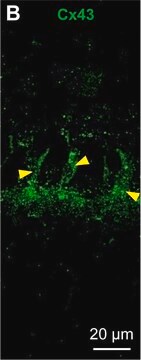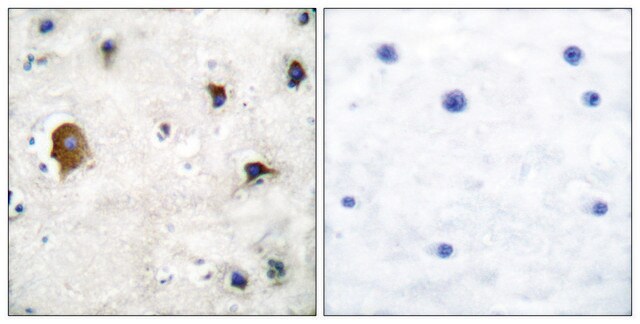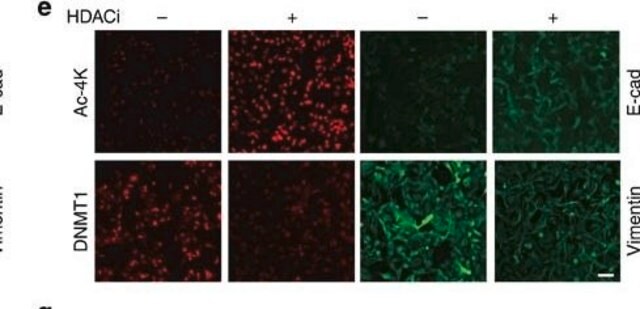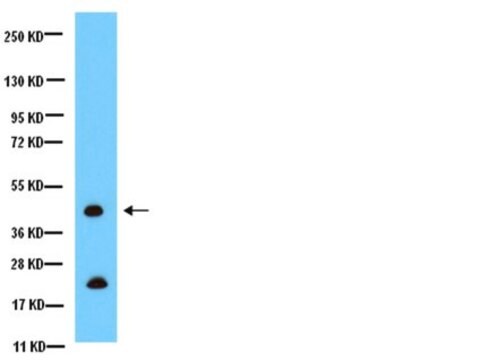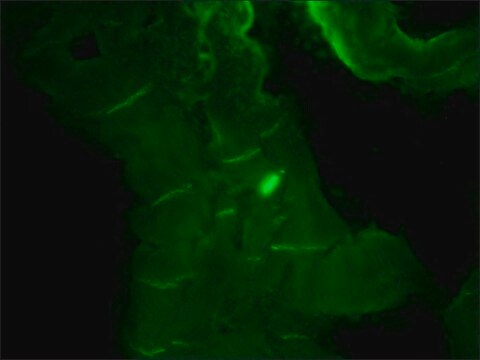AB1727
Anti-Connexin 43 Antibody
CHEMICON®, rabbit polyclonal
Synonyme(s) :
Gap Junction alpha-1 Protein (CxA-1)
Sélectionner une taille de conditionnement
Sélectionner une taille de conditionnement
About This Item
Produits recommandés
Nom du produit
Anti-Connexin 43 Antibody, Chemicon®, from rabbit
Source biologique
rabbit
Niveau de qualité
Forme d'anticorps
affinity isolated antibody
Type de produit anticorps
primary antibodies
Clone
polyclonal
Produit purifié par
affinity chromatography
Espèces réactives
mouse, bovine, rat
Fabricant/nom de marque
Chemicon®
Technique(s)
ELISA: suitable
immunocytochemistry: suitable
immunohistochemistry: suitable
immunoprecipitation (IP): suitable
western blot: suitable
Description générale
a predicted M.W. of ~43 kDa. It is prominently expressed in heart (see reviews: Kumar & Giula 1996; White et al. 1995; Evans 1994; Beyer et al. 1990).
Spécificité
Immunogène
corresponding to amino acids 360-382 within
the C-terminus of mouse connexin 43.
Application
Immunocytochemistry: not tested. It is recommended that the antibody be tried at 2-20μg/mL in formaldehyde fixed (Beyer et al. 1985; Nicholson et al. 1985; John et al. 1991; Fishman et al. 1990).
Immunoblotting: 1-10μg/mL using Chemiluminescence technique.
Optimal working dilutions must be determined by end user.
Immunohistochemistry: A 1:50 dilution of this antibody detected Connexin 43 in sections from mouse heart tissue pretreated with Tris-EDTA buffer, pH 9.0. Proteins were visualized using a donkey anti-rabbit secondary antibody conjugated to HRP and chemiluminescence detection.
Cell Structure
Adhesion (CAMs)
Forme physique
Stockage et stabilité
Informations légales
Clause de non-responsabilité
Vous ne trouvez pas le bon produit ?
Essayez notre Outil de sélection de produits.
En option
Code de la classe de stockage
12 - Non Combustible Liquids
Classe de danger pour l'eau (WGK)
WGK 1
Point d'éclair (°F)
Not applicable
Point d'éclair (°C)
Not applicable
Certificats d'analyse (COA)
Recherchez un Certificats d'analyse (COA) en saisissant le numéro de lot du produit. Les numéros de lot figurent sur l'étiquette du produit après les mots "Lot" ou "Batch".
Déjà en possession de ce produit ?
Retrouvez la documentation relative aux produits que vous avez récemment achetés dans la Bibliothèque de documents.
Notre équipe de scientifiques dispose d'une expérience dans tous les secteurs de la recherche, notamment en sciences de la vie, science des matériaux, synthèse chimique, chromatographie, analyse et dans de nombreux autres domaines..
Contacter notre Service technique